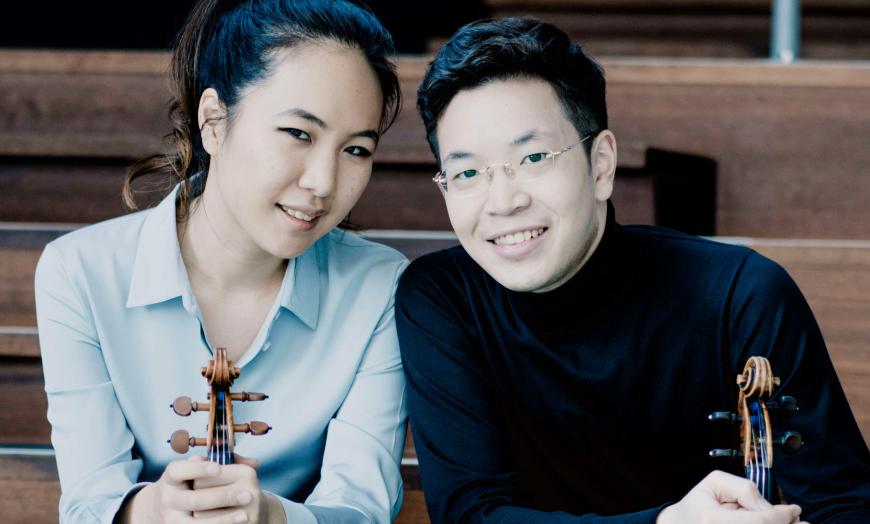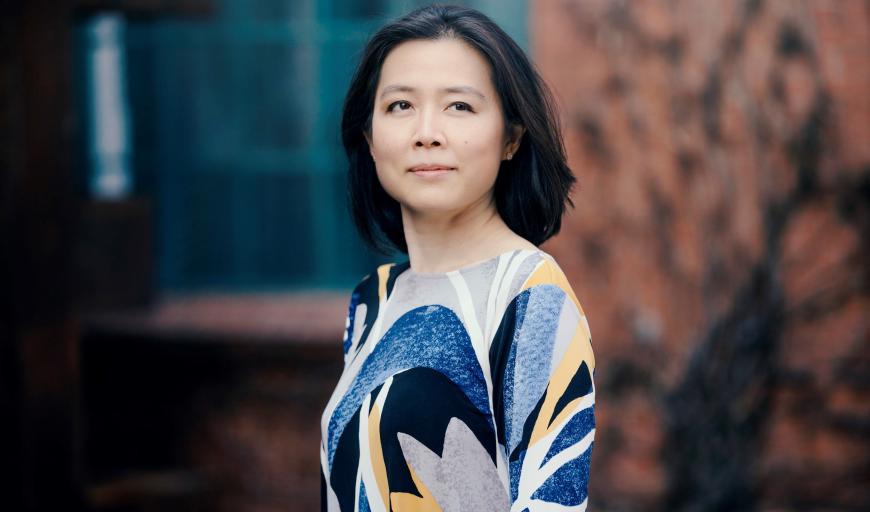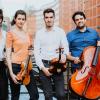
What’s better than one violin? Two violins! Chamber Music San Francisco brought Paul Huang and Danbi Um, soloists on that instrument, together with pianist Amy Yang at Herbst Theatre on Sunday, March 5. This was an excellent venue to hear the two violinists play both separately and together, with and without piano accompaniment. They presented a lively and winning exhibition of largely unfamiliar music.
The principal work displaying all three players was the Suite in G Minor, Op. 71, by Moritz Moszkowski. Moszkowski’s music is little heard today. He was a virtuoso pianist of Polish-Jewish origin, though by the time he wrote this piece in 1903, he was long retired from concertizing and was living in Paris to teach and compose.
Moszkowski knew how to write for a pair of violins. The two parts are closely matched, giving the same material together at different pitches, running after each other in imitative phrases, or complementing each other (such as a passage that has one player holding double stops while the other runs curlicues across the fingerboard). The work sounds more like a violin sonata with extra strings than a standard piano trio. The mood passes across the four movements from a dramatic and expository opening, through a tender and expressive Lento, to a zippy ending.

Um took the first violin part, playing with heavier force than Huang’s lighter and more ethereal style. But the two players’ tone colors were otherwise similar, and their unity wasn’t marred by sometimes bowing the same phrases in opposite directions at the same time.
There are few works for this combination of three instruments, but this challenging and complex piece is one of the most substantial. If there were more call for recitals like this one, Moszkowski’s Suite would be heard more often, and the musical world would be that much more enriched.
Um and Huang also played two briefer works written by violinists. Amy Barlowe’s Hébraïque Élégie for two violins unaccompanied (2001) has some of the same declarative quality as Moszkowski’s opening movement, with plenty of imitative echo between the violins as they navigate through melodies evoking Ashkenazi Jewish liturgical and folk music.
Pablo de Sarasate’s Navarra for two violins and piano (1889) functioned as an encore, though it was listed as part of the main program. Sarasate, who considered any moment onstage wasted if he wasn’t playing, could have taken either part of this piece. Whether showing off in double stops, on extreme high notes, or in the complex, precise rhythms of Spanish music, the two violins have to be precisely together throughout almost the whole of this piece, neither giving an inch to the other. These performers completed the concert with the intended flair.
Each of the violinists also played a solo sonata with the tireless Yang accompanying at the piano.
Huang’s solo was the Sonata No. 1 in A Major, Op. 13 (1876), by Gabriel Fauré. He played this with a notably graceful line, giving an urgent, questing quality to the opening Allegro molto, which made it resemble the same movement of the César Franck Violin Sonata. Yang’s cascading and overlapping notes at the piano added a hint of Debussy to the proceedings. Light and perky cheerfulness in the Scherzo (marked Allegro vivo) made a pleasant contrast.
Um played the Poème mystique, or Violin Sonata No. 2 (1924), by Ernest Bloch. This is about the same length as the Fauré, some 20 minutes, but forms a single unbroken movement. It’s also a tougher, darker piece. Um provided character by giving the declarative exposition a variety of tone colors and shifting expressions. Lyric phrases elegantly disappeared off the high end of her violin. Yang pushed the rhythm in the piano to drive the energy on. As in many of his pieces, Bloch provides a hint of Jewish musical character to the melodic line, but here he also quotes Catholic plainchant, making for an ecumenical composition.


